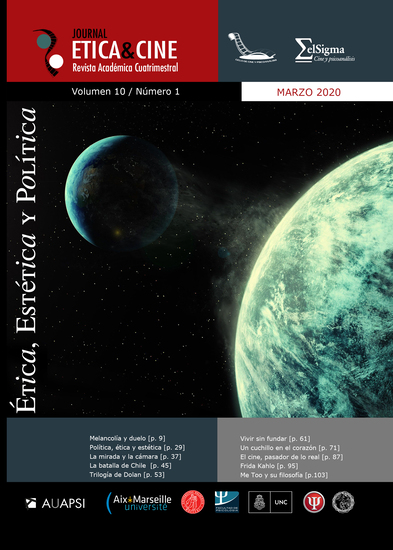The battle of Chile: image, poetry, memory
DOI:
https://doi.org/10.31056/2250.5415.v10.n1.29210Keywords:
Trauma, Coup, Memory, Image, PlayAbstract
The trauma, by definition, leaves no traces in the psychic apparatus. This absence becomes even more complex when the trauma is linked to state
violence, which leaves only shapeless, discontinuous and fragmented traces. When we are confronted with this type of experience, the construction
of a movement-image as the basis of a narrative allows us to integrate these experiences, even that of the trauma, by deploying an individual novel, a
memory and a collective myth of horror. However, it is not the simple reference to the image that this access to a narrative makes possible, but rather
a fantastic-fictionnal one, shifted from any « ordinary sense » and which the narrative organizes by the “figuration” which it deploys around an
enigmatic void. It is from the films in which the South African artist William Kentridge questions the function of the “memorial” in sites, sometimes
forgotten, having witnessed the violence of apartheid, that I propose an approach to the mutation of registers that can be seen in the work of the
documentary filmmaker Patricio Guzman, between the pure inscription of the image in “La batalla de Chile”, up to the poetic montage of “Nostalgia
de la luz”. In this analysis, I propose a parallel between the poetic function of the movement-image and the question of fantasy in Freud, to then
think about the notion of creativity, defined as the possibility of accessing life from primary shapeless traces by DW Winnicott.
References
Freud, S. Cartas a Wilhelm Fliess (1887-1904). Buenos Aires, Amorrortu, 1986.
Freud, S. (1901). L’interprétation du rêve[La interpretación de los sueños] (J-P Lefebvre traductor). Paris, Seuil, 2010.
Freud, S. (1910). “Un recuerdo infantil de Leonardo de Vinci”. En: Obras Completas, Madrid, Biblioteca Nueva, cuarta edición, 1981.
Freud, S. (1919). “Pegan a un niño”. Contribución al conocimiento de la génesis de las perversiones sexuales. En Obras Completas. Madrid: Biblioteca Nueva, cuarta edición, 1981.
Freud, S. (1920). “Más allá del principio del placer”. En: Obras Completas, tomo 18 (1920-1922). Buenos Aires, Amorrortu, 1976.
Heiduschka, V. (productor) y Haneke, M. (director). (2005). Caché [cinta cinematográfica]. Austria, Francia, Alemania e Italia: Artificial Eye; Sony Pictures Classics.
Humphreys, D. (2018). ”Figurabilidad fílmica: el estatuto pictográfico del cine”. Ética y cine, vol. 8 (2), Buenos Aires.
Kentridge, W. (1994). Six drawing lessons. Harvard, University Press.
Kentridge, W. (productor y director). (1994). Felix in Exile [cinta cinematográfica]. Sudáfrica.
Kristeva, J. (1980). Pouvoirs de l’horreur. Essai sur l’abjection. Paris: Seuil.
Mendelsohn, D. (2006). The Lost : A Search for Six of Six Million. New-York: Harper Collins Libri.
Milkaeloff, H. (curador). Catálogo de la exposición Chili, l’envers du décor/Fondation Louis Vuitton. Paris, Studio Graphique L. Vuitton, 2010.
Sachse, R. (productor) y Guzman, P. (director). (2010). Nostalgia de la luz [cinta cinematográfica]. Chile, Francia, Alemania: Pyramide.
Winnicott (1971). Realidad y Juego. Barcelona, Gedisa, 1993.
Downloads
Published
Issue
Section
License
Copyright (c) 2020 Ética y Cine

This work is licensed under a Creative Commons Attribution-ShareAlike 4.0 International License.
Los autores que publiquen en Ética y Cine Journal aceptan las siguientes condiciones:
Los autores/as conservan los derechos de autor © y permiten la publicación a Ética y Cine Journal, bajo licencia CC BY-SA / Reconocimiento - Reconocimiento-CompartirIgual 4.0 Internacional. La adopción de esta licencia permite copiar, redistribuir, comunicar públicamente la obra, reconociendo los créditos de la misma, y construir sobre el material publicado, debiendo otorgar el crédito apropiado a través de un enlace a la licencia e indicando si se realizaron cambios.

Este obra está bajo una licencia de Creative Commons Reconocimiento-CompartirIgual 4.0 Internacional.




